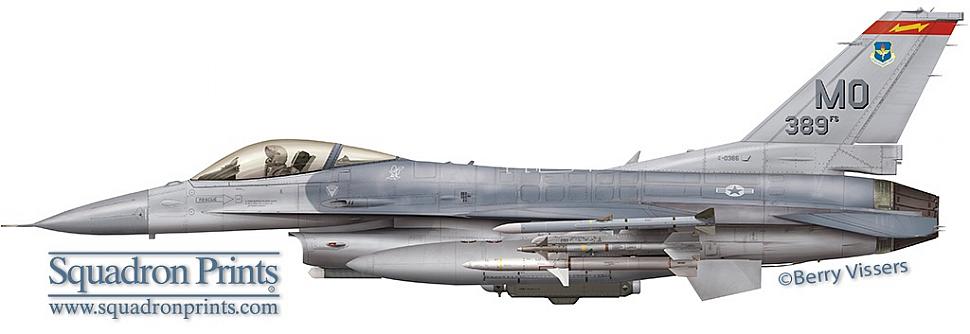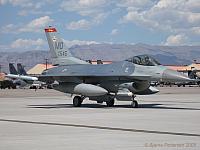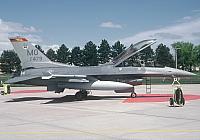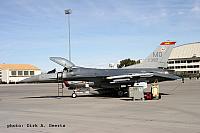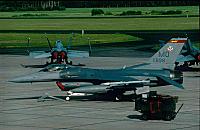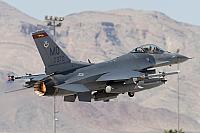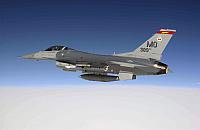 |
389th Fighter Squadron ( USAF ACC)" Thunderbolts" |
 |
389 FS " Thunderbolts" ( USAF ACC) | |||
| Status: |
Converted
|
|||
| Version: | F-16C/D block 52 | |||
| Role: | Multirole, SEAD | |||
| Tailband: | Red (with yellow thunderbolt) | |||
| Motto: | T-Bolts Rule | |||
| Badge: | N/A | |||
|
Converted to the F-15E on March 16th, 2007.
|
||||
F-16 History
The 389th FS started receiving the first F-16s in late 1991 already, even before the squadron was officially established. At first these were block 25 airframes coming from different disbanded squadrons. These airframes were merely used to get familiar with the type, since the squadron was earmarked to become a full SEAD capable unit. The block 25 airframes are not suited for this mission. So the squadron was left with a basic air-to-ground assignment for the time being.
This situation was quite quickly resolved as the unit began receiving brand-new block 52 units in early 1994. With these airframes came the HARM targeting system (HTS) and the corresponding AGM-88 missile. This made the deployment of the Suppression of Enemy Air Defense (SEAD) role possible. The unit was quite unique in this sense that it was one of only a few stateside units being able to perform this task. The squadron was tasked very soon to take part in the different deployment rotations all over the world.
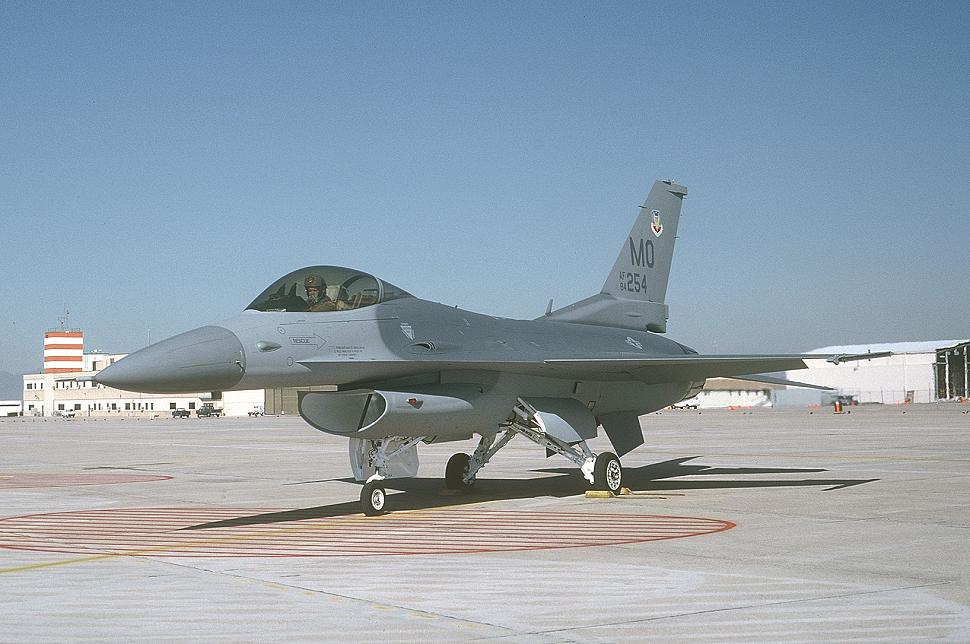
At the beginning of block 52 operations the squadron was dedicated to this SEAD task. Over the years more and more updates became available for the block 52 airframes – CCIP and others – with these airframes being able to be deployed in a multirole mission profile. The squadron got the opportunity to employ the LANTIRN system and fly high profile attack missions using this pod and night vision goggles together with advanced precision guided munitions. All these upgrades made it possible from halfway the 2000s to deploy both the HTS as the LANTIRN (or their successors) at the same time. A new mission profile was established, being called Destruction of Enemy Air Defenses (DEAD). In the past two missions had to be flown to perform this task, but it could be combined into one with the same aircraft deploying both the anti-radar missiles as the precision guided munitions to finish off the job at once.
In the 2005 BRAC a number of units were slated for disbandment. Unfortunately the 389th FS was axed. However the squadron would be receiving the F-15E aircraft to perform the deep strike mission. The squadron still flies this type up until today (2011). Remarkable fact about the F-16 operations within the 389th is that in 15 years of F-16 operations, the squadron didn’t lose one aircraft due to an accident.
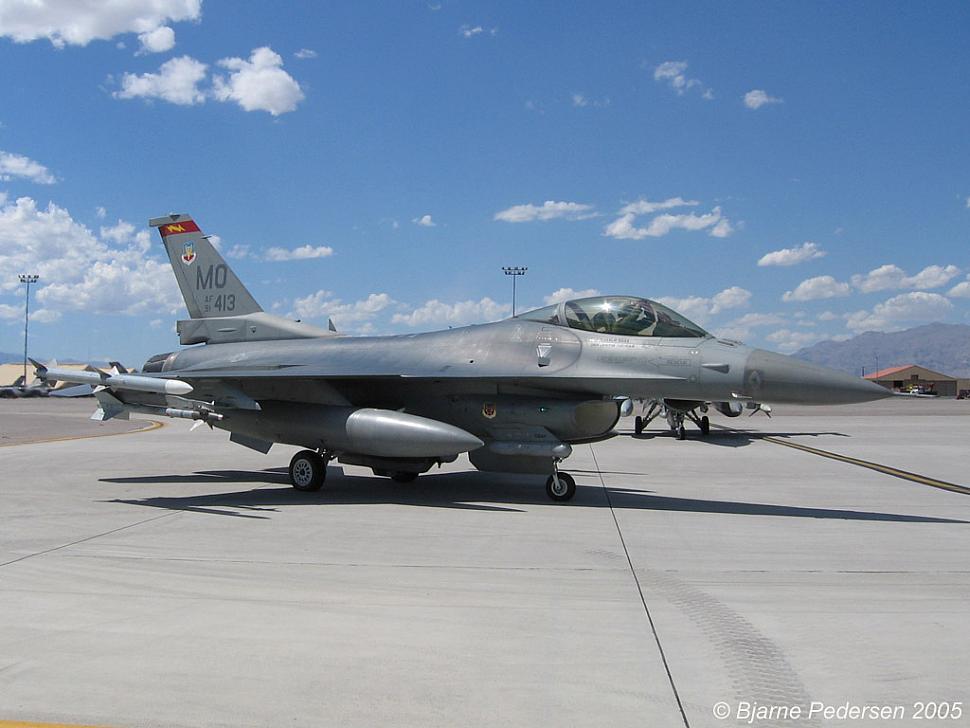
Aircraft Markings History

The tail consists of a red tailband with a yellow lightning strike enclosed. The 'MO' tailcode (for Mountain Home) is in the center of the tail with the Air Combat Command logo in between them. The serial number is at the bottom of the tail.
Unit History
- 1943: Activation of the squadron in Richmond, Virginia
- 1943: P-47D 'Thunderbolt' (part of 366 FG)
- 1943: P-47D 'Thunderbolt' (Bluethental, North Carolina)
- 1943: P-47D 'Thunderbolt' (Richmond AAB, Virginia)
- 1944: P-47D 'Thunderbolt' (Membury [Eng.])
- 1944: P-47D 'Thunderbolt' (Thruxton [Eng.])
- 1944: P-47D 'Thunderbolt' (St. Pierre du Mont [Fr.])
- 1944: P-47D 'Thunderbolt' (Dreux [Fr.])
- 1944: P-47D 'Thunderbolt' (Laon [Fr.])
- 1944: P-47D 'Thunderbolt' (Asch [Bel.])
- 1945: P-47D 'Thunderbolt' (Munster [Germ.])
- 1945: P-47D 'Thunderbolt' (Bayreuth [Germ.])
- 1945: P-47D 'Thunderbolt' (Fritzlar [Germ.])
- 1946: Disbanded
- 1952: Activation of the squadron in Alexandria, Louisiana
- 1952: F-51 'Mustang' (part of 366 FBG)
- 1953: F-86 'Sabre'
- 1955: F-84 'Thunderjet'
- 1957: F-84 'Thunderjet' (part of 366 FBW)
- 1958: F-100 'Super Sabre' (part of 366 TFW)
- 1959: Disbanded
- 1962: Activation of the squadron in Chaumont [Fr.]
- 1962: F-84 'Thunderjet' (part of 366 TFW)
- 1963: F-100 'Super Sabre' (Homestead AFB, Florida)
- 1965: F-4D 'Phantom II'
- 1966: F-4D 'Phantom II' (Phan Nang AB [S. Vietn.])
- 1966: F-4D 'Phantom II' (Da Nang AB [S. Vietn.])
- 1969: F-4D 'Phantom II' (part of 37 TFW, Phu Cat AB [S. Vietn.])
- 1970: F-4D 'Phantom II' (part of 12 TFW)
- 1971: F-111 'Aardvark' (part of 347 TFW, Mountain Home AFB, Idaho)
- 1972: F-111 'Aardvark' (part of 366 TFW)
- 1991: Deactivated
- 1992: Activation of the squadron in Mountain Home, Idaho
- 1992: F-16C/D 'Fighting Falcon' (part of 366 OG)
- 2007: Converted
Deployments
 |
' Provide Comfort' |
| Incirlik AB, Turkey (March of 1995 to May of 1995) | |
| Operation Provide Comfort was a US European Command Combined Task Force (CTF) who was responsible for support for the Iraqi Kurds above the 36th parallel in Iraq. | |
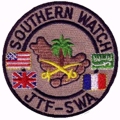 |
' Southern Watch' |
| Al Jaber AB, Kuwait (April of 1996 to June of 1996) | |
| Operation Southern Watch was an operation which was responsible for enforcing the United Nations mandated no-fly zone below the 32nd parallel in Iraq. This mission was initiated mainly to cover for attacks of Iraqi forces on the Iraqi Shi’ite Muslims. | |
 |
' Southern Watch' |
| Sheik Isa AB, Bahrain (April of 1997 to July of 1997) | |
| The second operation Southern Watch deployment was part of rotation cycle AEF V. During this deployment a total of six aircraft had nose art applied on them. All these were removed very quickly on return to CONUS. | |
 |
' Southern Watch' |
| Al Jaber AB, Kuwait (April of 1998 to June of 1998) | |
| The second operation Southern Watch deployment was part of rotation cycle AEF VII. A Total of 220 airman were deployed during this mission. | |
 |
' Southern Watch' |
| Prince Sultan AB, Saudi Arabia (February of 1999 to April of 1999) | |
| This marked the last deployment in the series of operation Southern Watch for the 389th FS. More than 1,000 sorties were flown during this deployment. | |
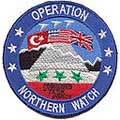 |
' Northern Watch' |
| Incirlik AB, Turkey (November of 1999 to January of 2000) | |
| Operation Northern Watch was a US European Command Combined Task Force (CTF) who was responsible for enforcing the United Nations mandated no-fly zone above the 36th parallel in Iraq. This mission was a successor to Operation Provide Comfort which also entailed support for the Iraqi Kurds. | |
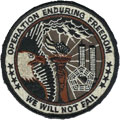 |
' Enduring Freedom' |
| Al Udeid AB, Qatar (November 7th, 2001 to January of 2002) | |
| Deployed specifically for Operation Enduring Freedom. Borrowed some F-16s from the 157th FS. This squadron marked two first milestones for using the GBU-31 Joint Direct Attack Munitions (JDAM) and the CBU-103 Wind Corrected Munitions Dispenser (WCMD) for the first time in combat. | |
 |
' Iraqi Freedom' |
| Al-Udeid AB, Qatar (March of 2003 to May of 2003) | |
| This deployment marked the largest for the 389th FS. A total of 350 airman were deployed. This also marked the last operational deployment for the squadron when operating the F-16. |
F-16 Airframe Inventory
- All 389 FS F-16s in our F-16 Aircraft Database (past and current aircraft)
- Current 389 FS F-16s in our F-16 Aircraft Database
Photos
Please use this form to add any list any error or omissions you find in the above text.
Note: your comments will be displayed immediately on this page. If you wish to send a private comment to the webmasters, please use the Contact Us link.

